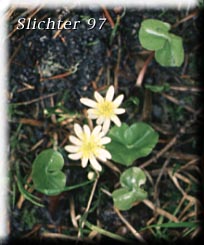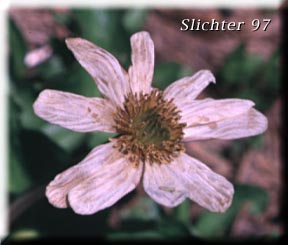 Photo at right of twinflowered
marshmarigold from Mt Hood Meadows, Mt. Hood N.F.. Note the rounded to kidney-shaped
leaves.
Photo at right of twinflowered
marshmarigold from Mt Hood Meadows, Mt. Hood N.F.. Note the rounded to kidney-shaped
leaves.
Twinflowered marshmarigold is a low growing, beautiful perennial wildflower of very moist places. It may have two flowers on a stem and has rounder leaves than its almost identical cousin, Caltha leptosepala. The basal leaves are long petioled and broadly rounded or kidney-shaped with a dark green, shiny upper surface. The petiole is longer than the blade, which may be up to 10 cm long and wide.
The flowers are actually six to twelve white sepals. Two flowers are usually found per plant. Petals are lacking. The yellow stamens and greenish pistils are centrally located and both are numerous. Marshmarigolds bloom within weeks of the snow melting. The fruits are many seeded pods.
This is a fine wildflower for the moist garden, and seems to be hardy in moist lowland gardens west of the Cascades once established. When established in thick stands, it is very attractive when in bloom.Twinflowered marshmarigold is found in very moist areas, including streambanks, moist meadows, and seeps from montane forests into the alpine zone.
Twinflowered marshmarigold is widely distributed in mountainous areas from Alaska south through British Columbia to the Olympic Mts. and Cascades of Washington and Oregon south into California. It is found eastward into Idaho, Colorado, and Utah.

Twinflowered marshmarigold from Elk Meadows, Mt. Hood Wilderness Area.....May 1987.